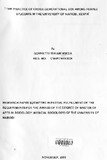| dc.description.abstract | Cross-generational sex is defined as a sexual relationship in which one person is older than the other by at least ten years. This study examined situations where the man is ten years or more older than the woman. Although generally believed to be a common practice in Africa, few studies have looked at the practice in Kenya. Its prevalence is therefore unknown. Further, the factors that motivate women to go for the practice in the University setting are not clear.
It is also not known what the consequences of such a relationship are and how the women involved mitigate against the consequences. This study therefore aimed to establish the prevalence of the practice among the regular female students in the University of Nairobi. It also aimed to find out what the motivating factors for cross-generational sex are among the students.
The study identified the measures and negotiation methods that female students take to ensure they do not get pregnant or sexually transmitted infections. The consequences of the practice were studied among the group including how the students manage the adverse consequences. This was a cross-sectional survey supplemented by focus group discussions (FGD) and key Informant interviews. Questionnaires were used to collect quantitative data while guide questions were used for the FGD and key informant interviews. Statistical Package for Social Sciences (SPSS) was used to manage the quantitative data. Dominant themes were identified from the FGD and key informant interviews. These have been used to explain the quantitative findings.
The study found that cross-generations sex was a common practice among the female regular students in the University of Nairobi with 36.4% of those interviewed admitting that they were in sexual relations with men who were ten years and above older than them. The major motivator to this practice was found to be financial benefits, a fact that was confirmed by 54% of the students engaging in cross-generational sex. Other factors that pushed female students to this practice were peer pressure, gifts, loneliness and poverty. To ensure they did not incur pregnancies and sexually transmitted diseases, 75% of the students used condoms as a protective measure while 13% used the emergency pill. As much as there were financial benefits in this relationships, students interviewed admitted that there were adverse consequences too.
The most common consequences according to the students was sexually transmitted disease and HIV. The other consequences were unwanted pregnancies, stress, dropping out of school and poor academic performance. In order to manage these consequently,students abort so that they are able to continue with studies. To manage stress and other consequences that affect academic work, most students cheat in exams by carrying short notes to exam room, pay their fellow students to do term papers for them among many more. Others have younger boyfriends whom they ran back to whenever they are frustrated by the older men. However, some students persevered the consequences for the sake of keeping the relationship.
It is therefore recommended that HELB loan should be increased, sexuality education be introduced at university level, affirmative action be applied when giving loans, instill ethics in the university staff and finally, the university to come up with alternative ways of assessing students' performance. The results of this study will enhance the development of strategies and interventions for the consequences of cross-generational sex. | en_US |

